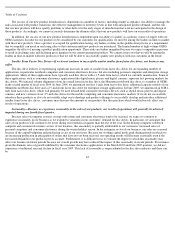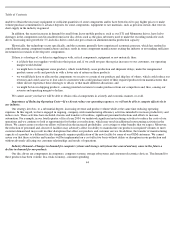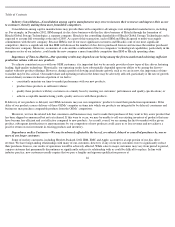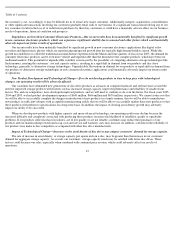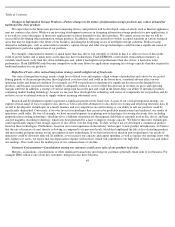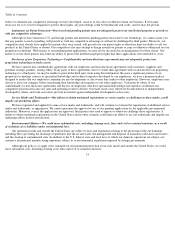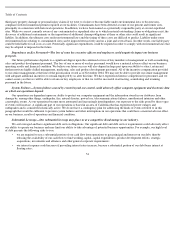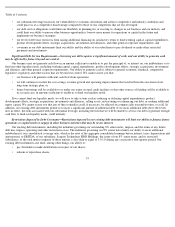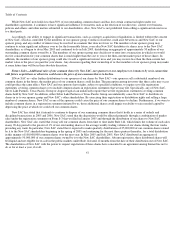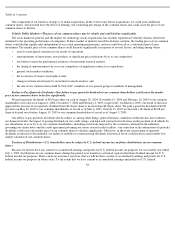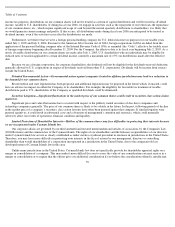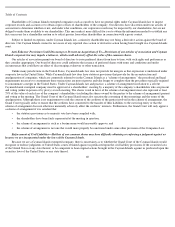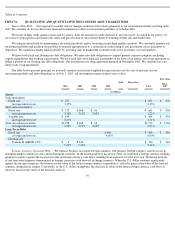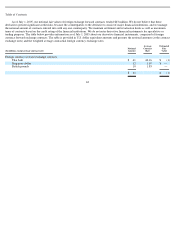Seagate 2004 Annual Report Download - page 55
Download and view the complete annual report
Please find page 55 of the 2004 Seagate annual report below. You can navigate through the pages in the report by either clicking on the pages listed below, or by using the keyword search tool below to find specific information within the annual report.
Table of Contents
Agreement. The Bankruptcy trustee withdrew his motion to approve the Seagate settlement. At a hearing on July 27, 2005, the Bankruptcy
Court approved the Western Digital settlement and set a hearing for September 28, 2005 on our 365(n) election to retain the benefits of the
Patent Cross-License Agreement.
To the extent that third party cross-licenses, including the Patent Cross License Agreement dated December 31, 1994 between Read-Rite
Corporation and Seagate Technology, Inc., are deemed not to have been properly assigned to us in the November 2000 transactions, our
inability to either obtain new licenses or transfer existing licenses could result in delays in product development or prevent us from selling our
products until equivalent substitute technology can be identified, licensed and/or integrated or until we are able to substantially engineer our
products to avoid infringing the rights of third parties. We might not be able to renegotiate agreements, be able to obtain necessary licenses in a
timely manner, on acceptable terms, or at all, or be able to re-engineer our products successfully. Moreover, the loss of or inability to extend
any of these licenses would increase the risk of infringement claims being made against us, which claims could have a material adverse effect
on our business.
Risk of Intellectual Property Litigation—Our products may infringe the intellectual property rights of others, which may cause us to
incur unexpected costs or prevent us from selling our products.
We cannot be certain that our products do not and will not infringe issued patents or other intellectual property rights of others.
Historically, patent applications in the United States and some foreign countries have not been publicly disclosed until the patent is issued, and
we may not be aware of currently filed patent applications that relate to our products or technology. If patents are later issued on these
applications, we may be liable for infringement. We may be subject to legal proceedings and claims, including claims of alleged infringement
of the patents, trademarks and other intellectual property rights of third parties by us, or our licensees in connection with their use of our
products. We are currently subject to a suit by Convolve, Inc. and the Massachusetts Institute of Technology and a suit pending in Nanjing,
China. In addition, as noted above, Read-Rite Corporation, in a letter dated November 20, 2002 and in correspondence since that date, asserted
that we do not currently have a license to Read-Rite Corporation patented technology and that our disc drive products infringe at least two
Read-Rite Corporation patents.
Intellectual property litigation is expensive and time-consuming, regardless of the merits of any claim, and could divert our
management’s attention from operating our business. In addition, intellectual property lawsuits are subject to inherent uncertainties due to the
complexity of the technical issues involved, and we cannot assure you that we will be successful in defending ourselves against intellectual
property claims. Moreover, software patent litigation has increased due to the current uncertainty of the law and the increasing competition and
overlap of product functionality in the field. If we were to discover that our products infringe the intellectual property rights of others, we
would need to obtain licenses from these parties or substantially reengineer our products in order to avoid infringement. We might not be able
to obtain the necessary licenses on acceptable terms, or at all, or be able to reengineer our products successfully. Moreover, if we are sued for
infringement and lose the suit, we could be required to pay substantial damages and/or be enjoined from using or selling the infringing products
or technology. Any of the foregoing could cause us to incur significant costs and prevent us from selling our products.
Dependence on Intellectual Property—If our intellectual property and other proprietary information were copied or independently
developed by competitors, our operating results would be negatively affected.
Our success depends to a significant degree upon our ability to protect and preserve the proprietary aspects of our technology. However,
we may be unable to prevent third parties from using our technology without our authorization, particularly in those countries where the laws
do not protect our proprietary rights as fully as in the United States, or protect us from independently developing or acquiring technology that is
similar to ours. For example, in its bankruptcy proceedings under Chapter 7 of the U.S. Bankruptcy Code, Read-Rite Corporation’s patents and
other intellectual property rights were sold to Western Digital Corporation, who will use this intellectual property to compete against us. The
use of our technology or similar technology by others could
52


